Chapter 8
Habit 3 – being kind to others
Being kind to others – so long as there are no strings attached – builds good feelings in both the recipient and the giver. In turn, it’s good to practise being kind to yourself.
•Kind acts
•What happens when we are kind to someone?
•Different ways of being kind
•Being kind to yourself
•Meanness turned around
Kind acts
Being kind towards others can be an unselfish act or an act for personal gain. The two generally go hand in hand, because when we are kind to others it usually gives us a good feeling.
However, altruistic acts are different to acts that have conditions attached. It helps children to know the difference, because some adults still haven’t separated the two. Some adults offer gifts with ‘strings attached’ in order to influence others using emotional means. Effectively, these are not gifts but a means of control. For example, a gift of money would have strings attached if you then check to see how they spend it. That is not really a kind act! Giving a gift and then taking it back or having a say on what they do with it is controlling. Offering to help someone and then letting them know that they owe you a favour is not a kind act, it’s more like a business negotiation!
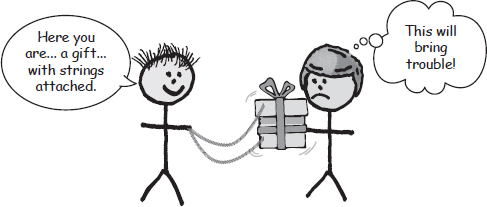
The habit of having strings attached to an act of kindness usually results in conflict and resentment and can be the source of strained relationships. We can help children not to carry this habit into adult life if we take time to explain the difference between being kind, and being kind with strings attached.
The idea that when we do something pleasant for someone, they should do the same back is about emotional fairness. A sense of emotional fairness and justice is not actually found in the Human circuits but is found in the Chimp circuits of the brain, and is seen in many species, including monkeys.[1]
This sense of fairness and balance means that if our Chimp kicks in when we are doing a kind act, it might add the strings and demand that there should be some trade-off.
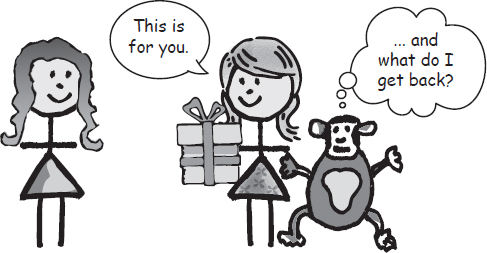
The Human circuits work more by way of morals and compassion and therefore tend not to add any strings to a kind act. The idea that what you do is what you expect others to do might seem reasonable, but it is flawed logic. It is seen in the old adage that, if I meet a lion and don’t intend to harm it, then it won’t harm me! So, you could argue, what’s the point of being kind? Apart from the altruistic aspect, there are still benefits to you.
What happens when we are kind to someone?
The evidence is clear that not only does the person to whom we are being kind feel good, but we also get a sense of well-being.[2] The main hormone that helps us to be generous is oxytocin and experiments show that if we boost this hormone in people then they become more generous.[3]
So oxytocin helps us to develop a sense of well-being. Even if we do not expect any return for our kindness, the evidence is that, when we are kind to someone, they will see us in a good light and also will be much more likely to do kind acts for us.[4] [5]
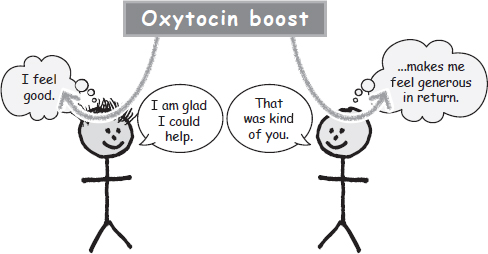
Different ways of being kind
There are various ways of being kind to someone and each can be learnt as a habit. Examples of being kind include:
•Offering kind or encouraging words
•Considerate and supportive behaviour
•Listening to someone
•Being thoughtful
•Putting someone else first
•Showing appreciation and acknowledging what someone has done for you
•Giving a gift without strings attached!
•Pleasantly surprising someone
With some reflection I am sure you can think of many ways of being kind to those around you. Apart from improving your own well-being, it is very likely to improve relationships.
Developing a habit of being kind is about programming your Computer to default into a kindness mode whenever you meet people. Sometimes it is not what we say that is the problem – the problem is what we do not say. Very often, people tell me that they forgot to tell someone what they mean to them or how much they appreciate them. But it isn’t difficult to develop a habit of being kind.
Suggested helpful habit
Try to greet someone with a genuinely pleasant comment.
Being kind to yourself
You can also be kind to yourself. One way to help with self-esteem is to praise yourself for the things that you have done and the values you possess. Too often, I see people constantly criticising themselves with no mention of praise. If you tend to do this, it’s worth asking if it is really helpful.
Children can also learn to be very self-critical, and this unhelpful habit can persist. Teaching them how to be kind to themselves is a productive basis for adult life. For a child, approval from an adult is a critical aspect to gain validity. Therefore, it helps not just to praise a child when you see them performing an act of kindness, but also to approve of them learning to praise themselves.
Important point
Praising yourself can be based on doing your best, not just achieving.
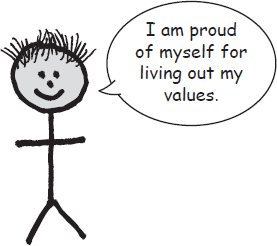
Meanness turned around
Seeing their child being mean to other children concerns some parents and carers. Whatever form this meanness takes, the important point is to recognise that it is natural, even though it is unwelcome. The Chimp will try and protect territories, such as toys, possibly dominate by trying to be better than others and will often use violence to achieve this dominance.
One way of making sure that someone will keep their distance from you in the future, so that you can protect your territory, is to make their encounter with you unpleasant! If you can see that this is what the Chimp within your child is doing, then it makes sense for them to be as unpleasant as possible towards other children. This can include biting, attacking and any other natural-but-unacceptable activity.
To move things forward, first accept that this is normal behaviour for a Chimp, even though it is unacceptable for society. I think it is important not to see the behaviour for more than what it is. The child is learning what it can and can’t do. The way a young child can do this is by carrying out behaviours and seeing which ones work to its advantage. We can therefore work with all three different systems to help the child: the Chimp, the Human and the Computer.
The Chimp will work purely with behaviours and looks for rewards or unrewarding outcomes.
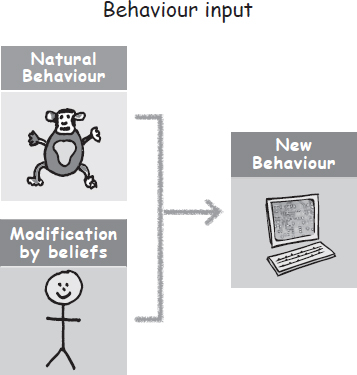
So disapproving of actions the child takes can be effective if, for example, following an unhelpful act of meanness by the child you withhold affection, withhold toys or place restrictions on activities. Another way is to tell them that you are upset and that they need to apologise to you and ask them to give you some space. I personally think it’s important to remind them that you still love them, despite their actions.
The problem with working purely with behaviours is that we are not helping the child to develop the Human parts of the mind, which are present but not developed. Therefore, in order to bring the Human circuits into action, we can discuss with the child why we are finding things unacceptable and why there are consequences to actions. Explaining in a calm and measured manner will help the child to move towards the Human circuits.
Important point
Be careful: if your explanation is given by using a lot of emotion, it is likely to keep the child in Chimp mode.
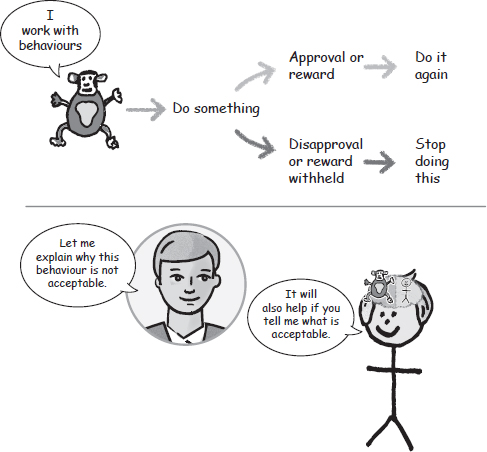
If the child understands the Chimp model, then it is possible to explain that they have a choice about whether to be Human or a Chimp. You could ask them directly if they want to be Human or Chimp and what kind of behaviours they would like to have. Let’s hope they say Human! Remind the child of how strong the Chimp is and how it can hijack them and try to fool them into believing they are a Chimp and not Human. My youngest student of the Chimp model was two, and she got it perfectly and was able to use the model going forward.
To bring the Computer system into play would entail sitting the child down, when they are not in an emotional state and you are not addressing any misdemeanour, and then helping to programme the Computer with a suitable response.
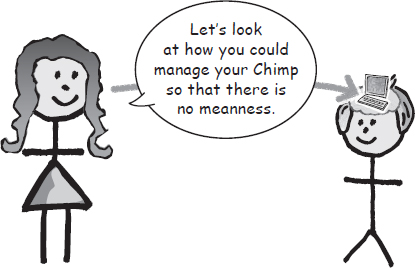
You could approach this by asking them how they would want to react if someone annoys or upsets them, and how they wouldn’t want to react. For example, they might want to let a brother, sister or friend know how they feel but not be mean or unkind to them. If you explain that their Chimp is very likely to react and therefore we need a learnt response to manage the Chimp, it could help the child to distance themselves from the Chimp. You could ask them: how could you manage your Chimp so that you are not mean?
A programmed response
This programmed response has to be feasible and practical. Every child is unique, so this means finding what will work for your child and yourself. For example, if a child is overwhelmed by emotion, asking them to find an adult and tell them how they feel, rather than reacting, will only work for some children. Those children it will work for would still need to practise this behaviour in order to ensure it is well ingrained as a first response. Alternative possible programmed behaviours, depending on the age of the child, could include:
•Preparing before an event – for example, deciding on which toys they will share and removing those that they don’t want to share before a friend arrives
•Learning a fixed response for removing frustration, such as being allowed to shout into the air
•Being assertive and explaining to the other child what they do and don’t want to happen and how they feel
Apart from having a learnt response, we can also help the child to form beliefs to place into the Computer.
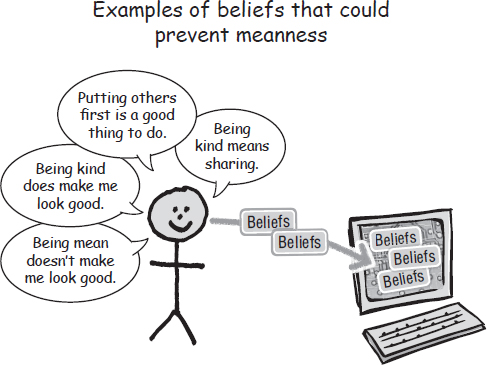
One difficulty when working with children is that we have to respect that their minds are not fully developed and allow for this. So younger children will work much more by using behaviours, and older children will move towards cognitive (thinking) ways of working. Can we help children with this transition? Yes! This leads us onto the topic of ‘theory of mind’, which is covered in the next chapter. Understanding it will help us to generally appreciate the development of the mind of a child.
Summary
•A kind act has no strings attached
•Being kind is a source of well-being
•There are lots of ways of being kind
•Be kind to yourself